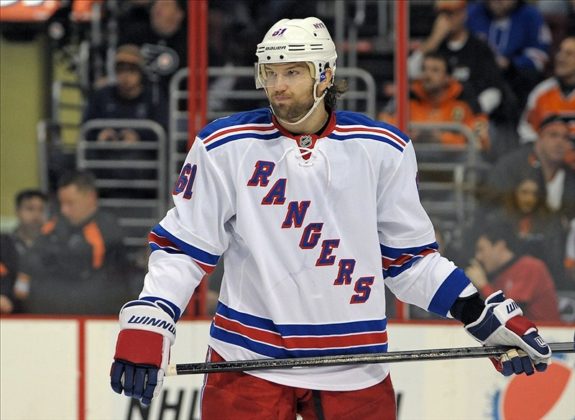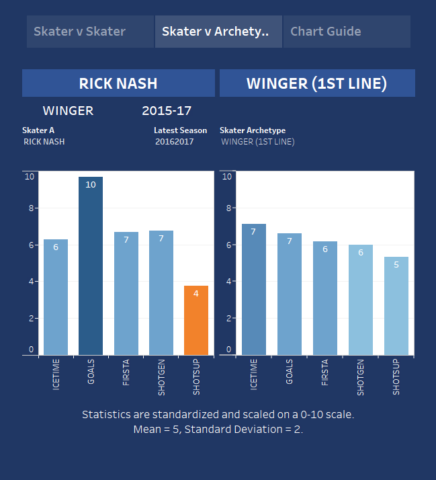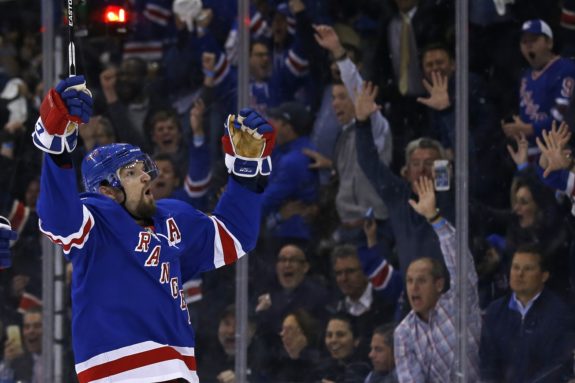For Rick Nash, trade rumors have become commonplace throughout his 14-year career. They persisted during his latter few years with the Columbus Blue Jackets before he was exported to the New York Rangers in a blockbuster deal. With the Blueshirts in a cap cluster over the past few seasons (with the exception being this summer), Nash’s future has been clouded by trade discussions due to his $7.8 million salary.
Now, with just one year left on his current deal, it looks like the Rangers will let Nash play out the final year of his deal and let him hit the open market next summer. Although the most likely scenario is for Nash to find a new home after this year, Jeff Gorton would be wise to gauge the 33-year-old’s interest in extending his stay on Broadway.
Despite playing in just 127 of a possible 164 games over the past two seasons, after posting a 42-goal, 69-point season back in the 2014-15 season, the lanky winger has been very effective for Alain Vigneault’s roster when healthy. He’s been quietly efficient on the penalty kill while his north-south style makes him a dangerous threat when he goes to the front of the net.

Even though many believe he hasn’t lived up to the lofty expectations that came with him to the Big Apple, or he hasn’t produced in the postseason (a narrative he has successfully debunked the past two years), the 2002 top overall pick has been an extremely productive two-way forward for the Blueshirts.
An extension may be in the best interest of both parties.
Nash’s Production
Although Nash’s numbers have taken a slight hit over the past two years, he’s arguably been the Rangers’ most productive player over the past few seasons. His ability to score has not wavered, as he ranked third on the team in G/60 with 1.01 despite shooting a measly 9.8% at five-on-five. He dominated on the man advantage as well, leading the Blueshirts with 2.67 G/60.

Nash has never been recognized as a dynamic feeder, but he has proven that he can drive the play. Of his 15 assists, 13 of them were primary. He has shown that he’s not afraid to get to the blue paint and generate scoring chances. Just ask the Montreal Canadiens, who Nash dominated in the first round of the playoffs this past season.
He has also shown that he is capable of being a top-tier winger even with all the criticism for not being the type of scorer that everyone believed he could be when he first arrived in New York.
Adequate Comparables
It was difficult to find a quality salary comparable for Nash for a few reasons, one being that a large percentage of multi-year deals given to players on the wrong side of 30-years-old have been brutal.
All you have to do is look at some of the deals that were flushed out last July. Andrew Ladd received a seven-year pact, Loui Eriksson’s deal pays him $6 million annually for the next five seasons, Frans Nielson’s funds will be awfully sufficient over the next five years ($5.25 million AAV), and the Boston Bruins paid a hefty price for David Backes’ services (five years at $6 million per).

I could go on with the bad deals but, the point is, that teams have been prone to breaking the bank for guys in this age range. Giving the world for Nash doesn’t make sense and if his asking price is too high, Gorton and company would be smart to walk away. However, I doubt this will be the case.
A good framework for a potential Nash extension could be the deal that Alex Steen signed with the St. Louis Blues back in September. He inked a four-year deal that carries an AAV of $5.75 million along with a No Trade Clause until February 1st, 2021 (via CapFriendly).
Yes, Steen and Nash are different players and Nash will be slightly older when his new deal kicks in, but I think this is a good starting point for both sides. Nash will certainly be looking for four years in any deal and I think the Rangers would be willing to match that. In terms of production, Nash is a superior scorer but Steen has been better in terms of point production. So a similar cap number should be expected.
The Final Product
If the Blueshirts and Nash agree on a deal, it will likely be slightly under the market threshold. A four-year deal that pays Nash just under $5 million annually could be enough to get Nash to stay. The other scenario is that the Rangers shoot for a lower term but a higher salary. If Nash would be open to this, a two-year deal with a cap hit of $6.5 million may make sense for both sides.
It’s a marriage that both sides should be interested in extending.